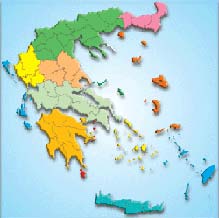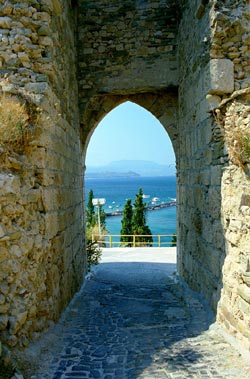
Please click on the map,
the region you want to visit |
|
|
|
|
| |
|
 |
The Castle of Koroni |
|
The castle of Koroni is dated back to the 6th-7th century - is an example of the Venetian fortress architecture. It belongs to the category of castles that in their interior have survived homes and temples. Highlights are: the church of Agia Sophia and of Agios Charalambos. The second one is an old Catholic church, which, during the Turkish occupation, was transformed into a mosque and nowadays serves as an orthodox church.
The castle
The shape of the castle of Koroni is probably square. It consists of two sets of walls, while the citadel is standing on its western part. It is worth mentioning that this point is the highest of the castle.
The north and the south side of the castle are overlooking the sea. On the south side, there are sharp rocks - the rocks of Resalto, which end at a beach. The north side, which is the main entrance of the castle, leads to the houses of the town that are stretching up to its west side while its east side is facing to Livadia.
The main entrance is shaped in a large square construction, where the peak, at its lower part, is ending to a pointed arch. At the highest point, where there was the room of the guards of the gate, there is a curved arch.
During the prosperous period of the castle, there was an entrance with columns on the right and on the left, while on the ceiling, there was a sculpture depicting the Lion of San Marco. Later, an inner courtyard, which was leading to the main entrance of the castle, made its appearance. This yard, over the years, was occupied by small houses.
For the construction of the wall, it was used stone and ancient building materials, which are visible in both: the large tower and the wall next to the monastery of Agios Ioannis the Baptist.
The great Wall in the north east side is the oldest part of the castle and the highest point is the Byzantine fortress where nowadays there is the nunnery.
To the east lies a lesser area, which was fortified in 1209, when the Venetians occupied Koroni. A second outer courtyard created then, four times larger in extend than the previous one. That way, the towers and the walls of the old fort had been strengthened. The interior was filled with constructions which were made by material that did not withstood into the time.
In the 16th century, the Turks strengthened the eastern edge with the appropriate artillery fortifications for them. An arched entrance leads inside the second fortification wall. This wall rises vertically, while at the northeast side it forms two round towers. Today, a large part of it, is damaged due to human intervention and to weather conditions.
At the westernmost tip, there is the most recent fort, originally built in the 15th century by the Venetians. In 1685, it was rebuilt because of the damage that had been suffered from. |

|
The sacred sites of the Acropolis of Koroni
When a visitor entries the gate towards the nunnery, he will see on his left side, a lower area. In this area is the church of "Agia Sofia".
The temple was initially small. Later, at the already existed position, one apartment was added. That way, the outside of the church looked like a bilateral with the original vaulted square section and the subsequent "narthex". Inside, the architecture is stunning and that makes it one of the most special temples.
According to the nuns and the local residents, the church is dedicated to Agia Sophia although there are evidences that the church is dedicated to God's Wisdom and not to Agia Sophia.
The monastery of the castle of Koroni
The monastery of Prodromos is located at the west side of Agia Sophia. It is feminine and it follows the old calendar. It consists of a small courtyard where there are many prominent shrines.
It must be noted that the premises of the castle are in use as a number of underground tanks, cells, caves, etc.
The most famous cave is "Skolio", in which one can navigate only with the permission and the presence of the abbot. The area has the form of a catacomb with the only difference that its majesty is highly visible. Its feature is the icons, which are placed on the rocks.
Here, it is built the highest rampart of the castle, which locals call "Megali Ntapia". Since it was built on the old cellars of the castle, should not be level, but high.
Agios Charalambos
Opposite the monastery is the tomb of Saint Charalambos, in whose temple the Catholics were honouring "Agios Rois".
The southern wall
The southern wall, located on the seaside, is associated with many folk tales full of mystery and fantasy. Nearby is the place of the Holocaust for freedom, the "Resalto".
When visitors pass through the west gate will meet the esplanade of Heroon. There lies the effigy of Bishop Gregory, in the grove of Eleistria. The park is a sacred place as there is the church of Panagia Eleistria because of her icon which earlier had been found there.
Panagia Eleistria
Panagia Eleistria is the protector of Koroni. All the residents honour her and many believers come to church to embrace her icon. According to residents, many miracles have been performed by the help of Eleistria.
The Icon of Eleistria was found on January 22, 1897, after some consecutive appearances of the Virgin Mary infront to a woman of the village, Maria Stathakis. At the rocky place, where the icon was found, were discovered two more icons, the crucified Crist and Agios Loukas, something that caused fear and excitement among residents.
The Icons were carved like small statues. The combination of all three is the current image of Eleistria. The strange thing is that they have been found on the rocks. One possible explanation is that a monk or a priest had wrapped them in a stole and hid them there in order to save them from a sacrilege.br>
The date of their manufacture and their creators remain a mystery. According to the Dutchman archaeologist Persson, the icons belong to the 5-6 century AD, while others argue that are ranked in the post-Byzantine era.
The temple was built on the spot where the images were found. The construction and the completion of the temple were made within three (3) years and the inauguration took place on December 26, 1900.
The Friday after the Easter, the day we honour Zoodochos Pigi, the holy church of Panagia Eleistria celebrates. On that day, the Divine Liturgy is celebrated by the Eminence Metropolitan of Messinia.
After this, follows the procession of the image on the streets of Koroni. Additionally, the church celebrates on March 25, on September 14 and January 22 (the day the icon was found).
|
 |
Accommodation proposals, entertainment and shopping in Koroni |
|
|
|